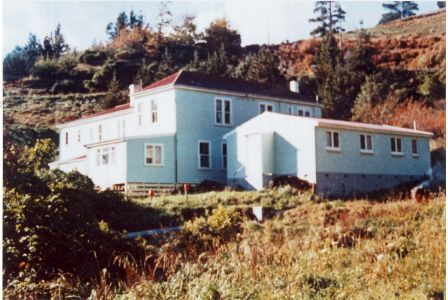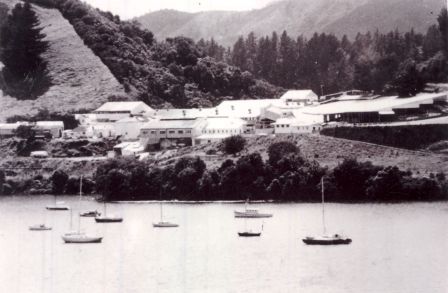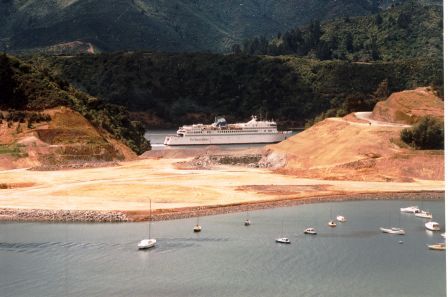Shakespeare Bay
Shakespeare Bay, in the Marlborough Sounds, near Picton has an interesting past.
Shakespeare Bay is a deepwater harbour just to the West of the main Picton harbour, separated by Kaipupu Point, now a wildlife sanctuary.
Although there is no record of Māori settlement in the bay, the original name, Kaipupu, (eating shellfish) shows that it was a well-known food gathering place. The English name was bestowed by early surveyors, even before Picton was named. The bay was settled by Pakeha fairly early - Edward and Mary Ann Clemens moved there in 1861 and raised a family of 14 children. Edward was related to the American author Mark Twain, whose real name was Samuel Clemens. Edward Clemens prospected for coal without success and turned to farming.
Shakespeare Bay is also interesting geologically – as long ago as 1864, officers of the Mines Department found a large fracture following an earthquake fault line running along the shore of the bay.
Although Mr Clemens was unsuccessful, coal was discovered there several times – in 1874, 1877 and 1881, and in 1907 an English company secured coal prospecting rights. After 1884 no work of any consequence was done on the Shakespeare Bay coal, but about 1893 there was a renewal of prospecting in the locality. No tangible results followed. A report in 1988 noted that, although coal exists in the locality, few seams are now exposed at the surface and are extensively sheared by faults.
Construction of the Freezing Works on Kaipupu Neck, which was completed in 1900, resulted in Shakespeare Bay receiving the foul runoff. During the Depression and War years the whole of Shakespeare Bay was farmed by the Henson family. Mr Henson also worked at the freezing works as a shepherd. Shakespeare House, the boarding house for single men, was built nearby.
In 1965 the Edwin Fox Restoration Society was formed and Edwin Fox was purchased for one shilling. She had been used as a coal hulk for the freezing works since 1905, and after a local battle about where she should be kept, the ship was towed to Shakespeare Bay after being emptied and refloated. She lay there for about twenty years, gradually being stripped for souvenirs and firewood until she was assigned a permanent berth in Picton Harbour. Volunteers worked for weeks to clear the hold and pump her out, she was inspected for damage and refloated, and on 4 December 1986 was towed to a new berth in Picton.
The next exciting event in the bay was the police search of Scott Watson’s boat Blade in June 1988, during investigations into the murder of Ben Smart and Olivia hope. The boat was moored in Shakespeare Bay. It was later moved to a hanger at Woodbourne Air Base for forensic examination, then returned to the family.
Once the Freezing Works had closed and eventually been demolished, the way became clear for construction of Waimahara Wharf, which was opened in May 2000. ‘Waimahara’ means ‘the waters of memory and recollection’, and the wharf was built for timber export on land bought by the Harbour Board years before in readiness for a deep water port. Later that year over 300 people attended a Picton Freezing Works reunion, and unveiled a plaque on Shakespeare Bay Lookout.
A serious fire in January 2001 led to days of monitoring by volunteer fire fighters, and from 2007 on a series of protests were organised against the use of methyl-bromide fumigant on Port Marlborough land in the bay. Shakespeare Bay continues to play a role in local affairs and to attract attention.
This story is condensed from a series written by Loreen Brehaut for the Seaport News in Picton, 2010
Updated May 2020
Story by: Loreen Brehaut
Further Sources
Newspapers
- Campbell, N. (1987) New export port at Picton : a good idea or not? Rails, 17(4), p.80-83
-
Late Cenozoic thrust tectonics, Picton, New Zealand. (1990) New Zealand journal of geology and geophysics 33(3)
-
Stockpile coal plan `undercuts Lyttelton' (1999, August 19) The Press, 1999, p. 7
Websites
- Marlborough freezing works (1899, August 4). Marlborough Express, p. 4.
http://paperspast.natlib.govt.nz/cgi-bin/paperspast?a=d&cl=search&d=MEX18990804.2.45 - Port Marlborough, New Zealand: Shakespeare Bay - Waimahara Wharf
https://portmarlborough.co.nz/about/
 Shakespeare House. Picton Historical Society. Click to enlarge
Shakespeare House. Picton Historical Society. Click to enlarge Freezing works, Kaipupu. Picton Historical Society.
Freezing works, Kaipupu. Picton Historical Society.  Logging port development, Shakespeare Bay. Picton Historical Society.
Logging port development, Shakespeare Bay. Picton Historical Society.